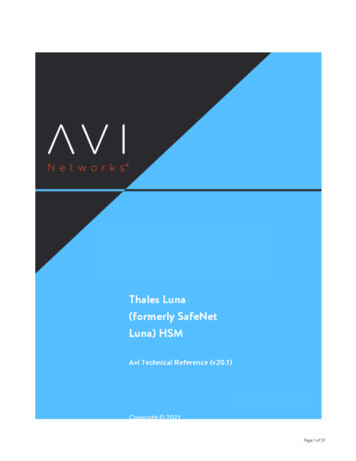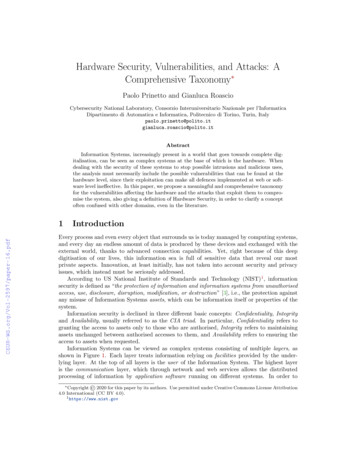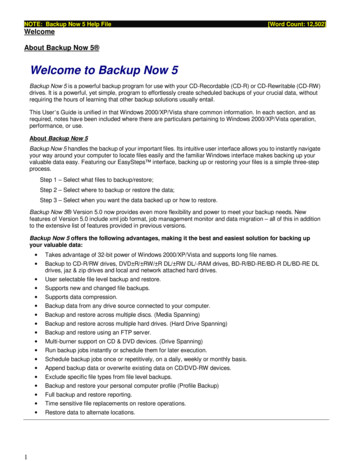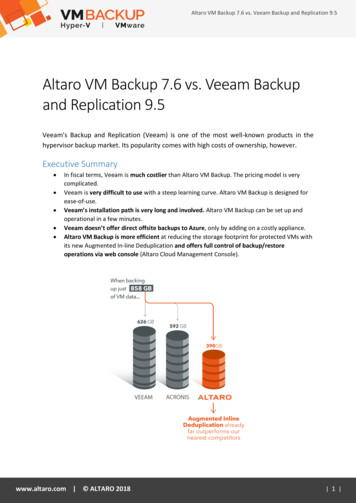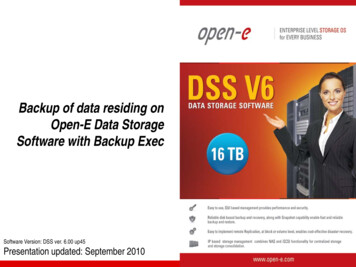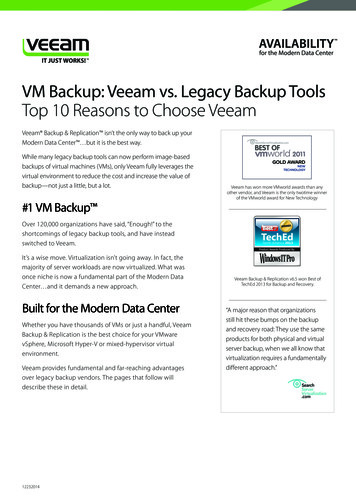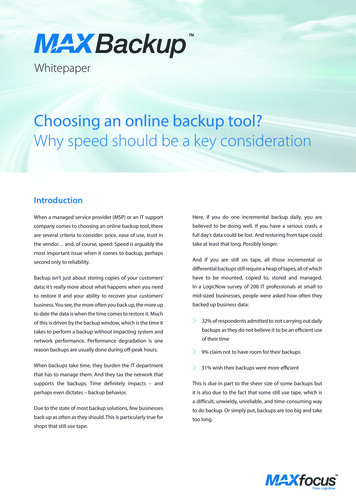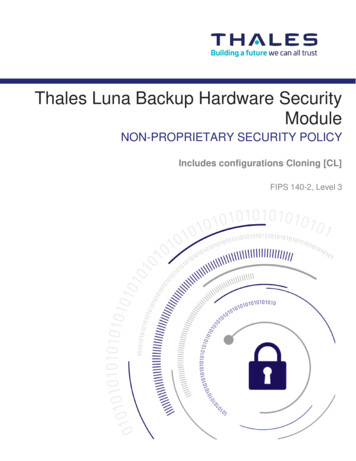
Transcription
Thales Luna Backup Hardware SecurityModuleNON-PROPRIETARY SECURITY POLICYIncludes configurations Cloning [CL]FIPS 140-2, Level 3
Document InformationDocument Part Number002-010965-001Release DateJanuary 25, 2021Revision HistoryRevisionDateReasonGNovember 18,2020The document has been updated to be consistent in style to other ThalesSPs including updates to both branding and product name.HJanuary 25,2021Removed 186-2 Signature Generation and updated Tamper LabelPicture.Trademarks, Copyrights, and Third-Party Software 2021 Thales. All rights reserved. Thales and the Thales logo are trademarks and service marks of Thalesand/or its subsidiaries and are registered in certain countries. All other trademarks and service marks,whether registered or not in specific countries, are the property of their respective owners.DisclaimerAll information herein is either public information or is the property of and owned solely by Thales. and/or itssubsidiaries who shall have and keep the sole right to file patent applications or any other kind of intellectualproperty protection in connection with such information.Nothing herein shall be construed as implying or granting to you any rights, by license, grant or otherwise,under any intellectual and/or industrial property rights of or concerning any of Thales’s information.This document can be used for informational, non-commercial, internal and personal use only provided that: The copyright notice below, the confidentiality and proprietary legend and this full warning notice appearin all copies. This document shall not be posted on any network computer or broadcast in any media other than onthe NIST CMVP validation list and no modification of any part of this document shall be made.Use for any other purpose is expressly prohibited and may result in severe civil and criminal liabilities.The information contained in this document is provided “AS IS” without any warranty of any kind. Unlessotherwise expressly agreed in writing, Thales makes no warranty as to the value or accuracy of informationcontained herein.Thales hereby disclaims all warranties and conditions with regard to the information contained herein,including all implied warranties of merchantability, fitness for a particular purpose, title and non-infringement.In no event shall Thales be liable, whether in contract, tort or otherwise, for any indirect, special orconsequential damages or any damages whatsoever including but not limited to damages resulting from lossof use, data, profits, revenues, or customers, arising out of or in connection with the use or performance ofinformation contained in this document.Thales Luna Backup HSM - LEVEL 3 NON-PROPRIETARY SECURITY POLICY002-010965-001 Rev. H January 25, 2021, Copyright 2021 Thales.2
Thales does not and shall not warrant that this product will be resistant to all possible attacks and shall notincur, and disclaims, any liability in this respect. Even if each product is compliant with current securitystandards in force on the date of their design, security mechanisms' resistance necessarily evolves accordingto the state of the art in security and notably under the emergence of new attacks. Under no circumstances,shall Thales be held liable for any third party actions and in particular in case of any successful attack againstsystems or equipment incorporating Thales products. Thales disclaims any liability with respect to securityfor direct, indirect, incidental or consequential damages that result from any use of its products. It is furtherstressed that independent testing and verification by the person using the product is particularly encouraged,especially in any application in which defective, incorrect or insecure functioning could result in damage topersons or property, denial of service or loss of privacy.Thales Luna Backup HSM - LEVEL 3 NON-PROPRIETARY SECURITY POLICY002-010965-001 Rev. H January 25, 2021, Copyright 2021 Thales.3
CONTENTSACRONYMS AND ABBREVIATIONS . 6PREFACE. 91 Introduction . 101.11.21.3Purpose . 10Scope . 10Validation Overview . 102 Security Policy Model Introduction . 122.1Functional Overview . 12Assets to be Protected . 13Operating Environment . 133 Security Policy Model Description . 153.23.33.43.53.6Operational Policy . 15Module Capabilities . 16Partition Capabilities . 17Description of Operator, Subject and Object . 22Operator . 22Roles . 22Account Data . 23Subject . 24Operator - Subject Binding . 24Object . 24Object Operations. 24Identification and Authentication . 25Authentication Data Generation and Entry . 25Trusted Path . 26Remote PED Operation . 26Secure Messaging . 27M of N Authentication . 27Limits on Login Failures . 27Access Control . 28Object Protection . 30Object Re-use. 30Privileged Functions . 30Cryptographic Material Management . 31Key Cloning . 32Key Mask/Unmask. 32Key Wrap/Unwrap . 32Cryptographic Operations . 33Self-Tests . 37Thales Luna Backup HSM - LEVEL 3 NON-PROPRIETARY SECURITY POLICY002-010965-001 Rev. H January 25, 2021, Copyright 2021 Thales.4
3.73.83.93.103.11Firmware Security. 39Physical Security . 39Tamper Evident Labels . 40Secure Recovery . 41EMI / EMC . 41Fault Tolerance. 41Mitigation of Other Attacks . 424 User Guidance . 434.1FIPS-Approved Mode . 435 Security Policy Checklist Tables . 44Thales Luna Backup HSM - LEVEL 3 NON-PROPRIETARY SECURITY POLICY002-010965-001 Rev. H January 25, 2021, Copyright 2021 Thales.5
IntroductionACRONYMS AND ABBREVIATIONSTermDefinitionANSIAmerican National Standards InstituteCACertification AuthorityCKEKey Export with RACLCloning (a capability configuration used to allow the secure transfer of key objects fromone module to another for backup and restore and object replication purposes).CLICommand Line InterfaceCOCrypto OfficerCRCCyclic Redundancy CheckCRTChinese Remainder TheoremCSPCritical Security ParameterCUCrypto UserDAKDevice Authentication KeyDHDiffie HellmanDRBGDeterministic Random Bit GeneratorECCElliptic Curve CryptographyECDHElliptic Curve Diffie HellmanFIPSFederal Information Processing StandardGSKGlobal Storage KeyHAHigh AssuranceHOCHardware Origin CertificateHOKHardware Origin KeyHRNGHardware Random Number GeneratorHSMHardware Security ModuleThales Luna Backup HSM - LEVEL 3 NON-PROPRIETARY SECURITY POLICY002-010965-001 Rev. H January 25, 2021, Copyright 2021 Thales.6
IntroductionTermDefinitionKATKnown Answer TestKDFKey Derivation FunctionKEKKey Encryption KeyMACMessage Authentication CodeMaskingA Thales term to describe the encryption of a key for use only within a Thales HardwareSecurity Module.MICManufacturer’s Integrity CertificateMIKManufacturer’s Integrity KeyMSKManufacturer’s Signature KeyMTKMaster Tamper KeyMVKManufacturers Verification KeyPCIPeripheral Component InterconnectPEDPIN Entry DevicePINPersonal Identification NumberPKCSPublic-Key Cryptography StandardsPRNGPseudo-Random Number GeneratorPSKPartition Storage KeyPSOPartition Security OfficerPSSProbabilistic Signature SchemeRARegistration AuthorityRNGRandom Number GeneratorRPEDRemote PEDRPKRemote PED KeyRPVRemote PED VectorSAServer-AttachedSADKSecurity Audit Domain KeySALKSecurity Audit Logging KeyThales Luna Backup HSM - LEVEL 3 NON-PROPRIETARY SECURITY POLICY002-010965-001 Rev. H January 25, 2021, Copyright 2021 Thales.7
IntroductionTermDefinitionSCUSecure Capability UpdateSGSKSecondary Global Storage KeySFFSmall Form FactorSHSSecure Hash StandardSMKSecurity Officer’s Master KeySNCSigning No CloningSOSecurity OfficerSRKSecure Recovery KeySTCSecure Trusted ChannelTUKToken or Module Unwrapping KeyTVKToken or Module Variable KeyTWCToken or Module Wrapping CertificateTWKToken or Module Wrapping KeyUSKUser’s Storage KeyThales Luna Backup HSM - LEVEL 3 NON-PROPRIETARY SECURITY POLICY002-010965-001 Rev. H January 25, 2021, Copyright 2021 Thales.8
IntroductionPREFACEThis document deals only with operations and capabilities of the Thales Luna Backup HSM in the technicalterms of FIPS PUB 140-2, 'Security Requirements for Cryptographic Modules', 12-03-2002.General information on Thales HSM alongside other Thales products is available from the followingsources: the Thales internet site contains information on the full line of available products athttps://cpl.thalesgroup.com; product manuals and technical support literature is available from the Thales Customer Support Portalat https://supportportal.thalesgroup.com/csm; and technical or sales representatives of Thales can be contacted through one of the channels listed onhttps://cpl.thalesgroup.com/contact-usNOTE: You require an account to access the Customer Support Portal. To create a newaccount, go to the portal and click on the REGISTER link.Thales Luna Backup HSM - LEVEL 3 NON-PROPRIETARY SECURITY POLICY002-010965-001 Rev. H January 25, 2021, Copyright 2021 Thales.9
Introduction1 Introduction1.1 PurposeThis document describes the security policies enforced by the Thales Luna Backup HSM.1.2 ScopeThis document applies to Hardware Version LTK-03-0102 or LTK-03-0103 with Tamper EvidentLabels TEL-GEMALTO, TEL-SAFENET, TEL-SAFENET-2, TEL-TRAC and TEL-TRAC-THALES andwith Firmware Versions 6.24.6 or 6.24.7.The security features described in this document apply to the Thales Luna Backup HSM only and donot include any feature that may be enforced by the host appliance, client or Thales Luna PEDThe Thales Luna Backup HSM is available in a cloning (CL) configuration.The security policies described in this document apply to the Trusted Path Authentication (Level 3)configuration of the Thales Luna Backup HSM only and do not include any security policy that maybe enforced by the host appliance or server.1.3 Validation OverviewThe cryptographic module meets all level 3 requirements security requirements for FIPS 140-2,alongside the optional Environment Failure Protection (EFP) augmentation as summarized in thetable below:Table 1: FIPS 140-2 Security LevelsSecurity Requirements SectionLevelCryptographic Module Specification3Cryptographic Module Ports and Interfaces3Roles and Services and Authentication3Finite State Machine Model3Physical Security3Operational EnvironmentN/ACryptographic Key Management3EMI/EMC3Self-Tests3Design Assurance3Thales Luna Backup HSM - LEVEL 3 NON-PROPRIETARY SECURITY POLICY002-010965-001 Rev. H January 25, 2021, Copyright 2021 Thales.10
IntroductionSecurity Requirements SectionLevelMitigation of Other Attacks3Cryptographic Module Security Policy3Thales Luna Backup HSM - LEVEL 3 NON-PROPRIETARY SECURITY POLICY002-010965-001 Rev. H January 25, 2021, Copyright 2021 Thales.11
Security Policy Model Introduction2 Security Policy Model Introduction2.1 Functional OverviewThe Thales Luna Backup HSM is a standalone hardware cryptographic module in the form of a smalldesktop device that connects to a computer workstation or server via USB. The cryptographicmodule is contained within a secure enclosure that provides physical resistance to tampering andresponse if the enclosure is opened. The cryptographic boundary of the module is defined toencompass all components inside the secure enclosure. Figure 2-1 depicts the Thales Luna BackupHSM; Figure 2-2 depicts the Thales Luna Backup HSM cryptographic boundary.The module may be purchased as either a FIPS Level 2 or FIPS Level 3 module. The end user canconfigure the modules to operate in either FIPS mode of operation or non-FIPS mode of operation.Configuration in FIPS mode of operation enforces the use of FIPS-approved algorithms only. Forthe FIPS Level 3 module the use of trusted path authentication is enforced. The module's FIPSmode can be changed by policy; changing this policy is destructive and will zeroize the module'snon-volatile memory.A cryptographic module is accessed directly (i.e., electrically) via either the Trusted Path PIN EntryDevice (PED) serial interface or via the USB communications interface (located at the back of thedevice) with the host computer. A USB port, which is provided at the front of the device, will be usedto support future enhancements / functionality. A module provides secure key generation andstorage for symmetric keys and asymmetric key pairs along with symmetric and asymmetriccryptographic services. Access to key material and cryptographic services for users and userapplication software is provided through the PKCS #11 programming interface. A module may hostmultiple user definitions or “partitions” that are cryptographically separated and are presented as“virtual tokens” to user applications. Each partition must be separately authenticated in order tomake it available for use.This Security Policy is specifically written for the Thales Luna Backup HSM in a Trusted PathAuthentication (FIPS Level 3) configuration.Figure 2-1. Thales Luna Backup HSMThales Luna Backup HSM - LEVEL 3 NON-PROPRIETARY SECURITY POLICY002-010965-001 Rev. H January 25, 2021, Copyright 2021 Thales.12
Security Policy Model gure 2-2. Thales Luna Backup Cryptographic Boundary (with front bezel removed)Assets to be ProtectedThe module is designed to protect the following assets: User-generated private keys; User-generated secret keys; Cryptographic services; and Module security critical parameters.Operating EnvironmentThe module is assumed to operate as a key management and cryptographic processing unitconnected over USB to a security appliance that may operate in a TCP/IP network environment.The host appliance may be used in an internal network environment when key management securityis a primary requirement. It may also be deployed in environments where it is used primarily as acryptographic accelerator, in which case it will often be connected to external networks. It isassumed that the appliance includes an internal host computer that runs a suitably securedoperating system, with an interface for use by locally connected or remote administrators and aninterface to provide access to the module’s cryptographic functions by application services runningon the host computer. It is also assumed that only known versions of the application services arepermitted to run on the internal host computer of the appliance.It is assumed that trained and trustworthy administrators are responsible for the initial configurationand ongoing maintenance of the appliance and the cryptographic module.Thales Luna Backup HSM - LEVEL 3 NON-PROPRIETARY SECURITY POLICY002-010965-001 Rev. H January 25, 2021, Copyright 2021 Thales.13
Security Policy Model IntroductionIt is assumed that physical access to the cryptographic module will be controlled, and thatconnections will be controlled either by accessing the module via a direct local connection or byaccessing it via remote connections controlled by the host operating system and application service.Thales Luna Backup HSM - LEVEL 3 NON-PROPRIETARY SECURITY POLICY002-010965-001 Rev. H January 25, 2021, Copyright 2021 Thales.14
Security Policy Model Description3 Security Policy Model DescriptionThis section provides a narrative description of the security policy enforced by the module in its mostgeneral form. It is intended both to state the security policy enforced by the module and to give thereader an overall understanding of the security behaviour of the module. The detailed functionalspecification for the module is provided elsewhere.The security behaviour of the cryptographic module is governed by the following security policies: Operational Policy Identification and Authentication Policy Access Control Policy Cryptographic Material Management Policy Firmware Security Policy Physical Security PolicyThese policies complement each other to provide assurance that cryptographic material is securelymanaged throughout its life cycle and that access to other data and functions provided by theproduct is properly controlled. Configurable parameters that determine many of the variable aspectsof the module’s behaviour are specified by the higher level Operational Policy implemented at twolevels: the cryptographic module as a whole and the individual partition. This is described in section3.1.1.The Identification and Authentication policy is crucial for security enforcement and it is described insection 3.3. The access control policy is the main security functional policy enforced by the moduleand is described in section 3.3.7, which also describes the supporting object re-use policy.Cryptographic Material Management is described in section 3.4. Firmware security, physicalsecurity and fault tolerance are described in sections 3.6 through 3.10.Operational PolicyThe module employs the concept of the Operational Policy to control the overall behaviour of themodule and each of the partitions within. At each level, either the module or the partition is assigneda fixed set of “capabilities” that govern the allowed behaviour of the module or individual partition.The Security Officer (SO) or Partition Security Officer (PSO) establishes the Operational Policy byenabling/disabling or refining the corresponding policy elements to equate to or to be more restrictivethan the pre-assigned capabilities.The set of configurable policy elements is a proper subset of the corresponding capability set. Thatis, not all elements of the capability set can be refined. Which of the capability set elements havecorresponding policy set elements is pre-determined based on the “personality” of the partition ormanufacturing restrictions placed on the module. For example, the module capability setting for“enable domestic mechanisms & key sizes” does not have a corresponding configurable policyelement.There are also several fixed settings that do not have corresponding capability set elements. Theseare elements of the cryptographic module’s behaviour that are truly fixed and, therefore, are notsubject to configuration by the SO. The specific settings are the following:Thales Luna Backup HSM - LEVEL 3 NON-PROPRIETARY SECURITY POLICY002-010965-001 Rev. H January 25, 2021, Copyright 2021 Thales.15
Security Policy Model Description Allow/disallow non-sensitive secret keys – fixed as disallow; Allow/disallow non-sensitive private keys – fixed as disallow; Allow/disallow non-private secret keys – fixed as disallow; Allow/disallow non-private private keys – fixed as disallow; Allow/disallow secret key creation through the create objects interface – fixed as disallow; and Allow/disallow private key creation through the create objects interface – fixed as disallow.Further, policy set elements can only refine capability set elements to more restrictive values. Evenif an element of the policy set exists to refine an element of the capability set, it may not be possibleto assign the policy set element to a value other than that held by the capability set element.Specifically, if a capability set element is set to allow, the corresponding policy element may be setto either enable or disable. However, if a capability set element is set to disallow, the correspondingpolicy element can only be set to disable. Thus, an SO cannot use policy refinement to lift arestriction set in a capability definition.Module CapabilitiesThe following is the set of capabilities supported at the module level: Allow/disallow password authentication (disallowed in Trusted Path configuration); Allow/disallow trusted path authentication (allowed and must be enabled in Level 3configuration); Allow/disallow masking; Allow/disallow cloning; Allow/disallow non-FIPS algorithms; Allow/disallow SO reset of partition PIN; Allow/disallow network replication; Allow/disallow remote authentication; Allow/disallow forcing change of User authentication data; Allow/disallow offboard storage; Allow/disallow partition groups; Allow/disallow Remote PED (RPED) operations; Allow/disallow external Master Tamper Key (MTK) split storage; Allow/disallow Acceleration; Allow/disallow unmasking; Allow/disallow FW5 compatibility mode; Maximum number of partitions; Allow/disallow ECIES support; Allow/disallow force single domain;Thales Luna Backup HSM - LEVEL 3 NON-PROPRIETARY SECURITY POLICY002-010965-001 Rev. H January 25, 2021, Copyright 2021 Thales.16
Security Policy Model Description Allow/disallow unified PED key; Allow/disallow M of N; Allow/disallow small form factor backup/restore; Allow/disallow Secure Trusted Channel; Allow/disallow decommission on tamper; and Allow/disallow partition re-initialize.Partition CapabilitiesThe following is the set of capabilities supported at the partition level. All capability elements describedas “allow/disallow some functionality” are Boolean values where false (or “0”) equates to disallow thefunctionality and true (or “1”) equates to allow the functionality. The remainder of the elements areinteger values of the indicated number of bits. Allow/disallow changing of certain key attributes once a key has been created; Allow/disallow user key management capability. (This would be disabled by the SO/PSO at thepolicy level to prevent any key management activity in the partition, even by a user in the CryptoOfficer role. This could be used, for example, at a CA once the root signing key pair has beengenerated and backed up, if appropriate, to lock down the partition for signing use only.); Allow/disallow incrementing of failed login attempt counter on failed challenge responsevalidation (Ignore failed challenge responses); Allow/disallow activation; Allow/disallow automatic activation (auto-activation); Allow/disallow High Availability (HA) recovery; Allow/disallow multipurpose keys; Allow/disallow operation without RSA blinding; Allow/disallow signing operations with non-local keys; Allow/disallow raw RSA operations; Allow/disallow private key wrapping; Allow/disallow private key unwrapping; Allow/disallow secret key wrapping; Allow/disallow secret key unwrapping; Allow/disallow RSA signing without confirmation; Number of failed Partition User logins allowed before partitions is locked out/cleared. The defaultis 10 for user partition logins and Partition SO logins; SO/PSO can configure it to be 1 N 10.The default is 3 for SO logins; SO can configure it to be 1 N 3. Minimum/maximum PIN length (configurable 7 to 255); Allow/disallow remote authentication;Thales Luna Backup HSM - LEVEL 3 NON-PROPRIETARY SECURITY POLICY002-010965-001 Rev. H January 25, 2021, Copyright 2021 Thales.17
Security Policy Model Description Allow/disallow RSA PKCS mechanism; Allow/disallow CBC-PAD (un)wrap keys of any size; Allow/disallow private key SFF backup/restore; Allow/disallow secret key SFF backup/restore; and Allow/disallow Force Secure Trusted Channel.The following capabilities are configurable only if the corresponding capability/policy is allowed andenabled at the module level: Allow/disallow private key cloning; Allow/disallow secret key cloning; Allow/disallow private key masking1; Allow/disallow secret key masking; Allow/disallow private key unmasking; Allow/disallow secret key unmasking;The following tables summarize the module and partition capabilities, showing typical capability settingsfor Thales Luna Backup HSM’s used in the following configurations (An X indicates the default capabilitysetting for each configuration of the module.):Thales Backup product configurations: Cloning (CL).Table 3-1. Module Capabilities and sEnableSO can configure the policy toenable or disable the availability ofnon-FIPS algorithms at the time thecryptographic module is initialized.DisableNon-FIPS algorithms availableDisallowDisableEnableAllowDisablePassword authenticationDisallowXDisableThe cryptographic module mustoperate using FIPS-approvedalgorithms only. Must be disabledin FIPS modeSO can configure the policy toenable or disable the use ofpasswords without trusted path forauthentication.The cryptographic module mustoperate using the trusted path andmodule-generated secrets forauthentication.1Key masking is a Thales product feature that provides encrypted key output. Key masking provides AES 256-bitencryption employing additional proprietary obfuscation, which does not provide additional security. Within the termsof FIPS 140-2 and support
encompass all components inside the secure enclosure. Figure 2-1 depicts the Thales Luna Backup HSM; Figure 2-2 depicts the Thales Luna Backup HSM cryptographic boundary. The module may be purchased as either a FIPS Level 2 or FIPS Level 3 module. The end user can

